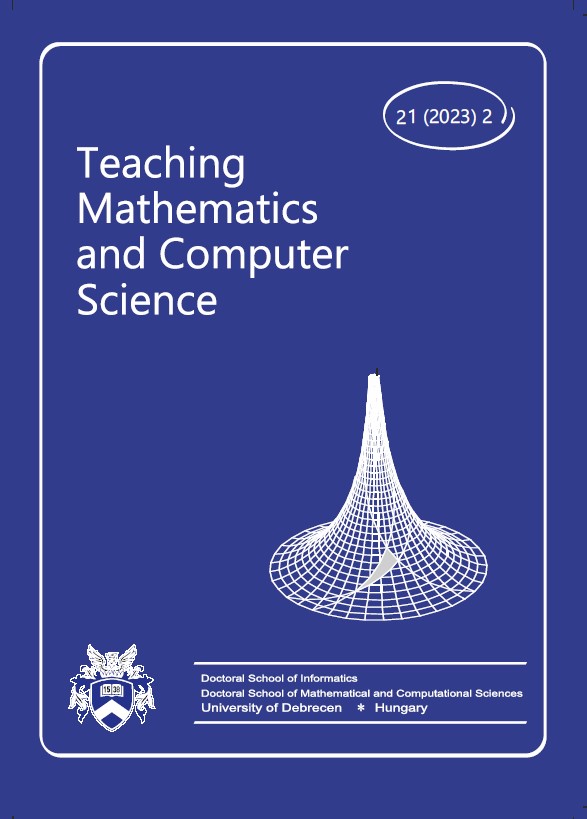The role of representations constructed by students in learning how to solve the transportation problem
Authors
View
Keywords
License
Copyright (c) 2024 Zoltan Pap, Gordana Stankov, Sanja Maravić Čisar

This work is licensed under a Creative Commons Attribution 4.0 International License.
How To Cite
Abstract
The purpose of the research presented in this paper was to study the role of concrete and table representations created by students in learning how to solve an optimization problem called the transportation problem. This topic was learned in collaborative groups using table representations suggested by teachers in 2021. In 2022, the researchers decided to enrich the students’ learning environment with concrete objects and urged the students to use them to present the problem to be solved. The students did it successfully and, to be able to record it in their notebooks, they constructed a table representation by themselves without any help from their teacher. After that, they managed to solve the problem by manipulating the objects. At the same time, each step in the solution was presented with changes in the table. The students were assessed before (pre-test) and after collaborative learning (test) in both academic years. The pre-test results were similar, but the test results were better in 2022. Therefore, it can be concluded that using concrete and table representations constructed by students in learning how to solve transportation problems makes collaborative learning more constructivist and more effective than when they use only table representations suggested by their teachers.
Subject Classification: 97M10, 97M40
References
- Binkley, M. et al. (2012). Defining Twenty-First Century Skills. In Griffin P. & McGaw, B. & Care, E. (Eds.), Assessment and Teaching of 21st Century Skills (pp. 17–76). Springer: Dortrecht, Netherlands.
- Bordner, G.M. (1986). Constructivism the theory of knowledge. J. Chem. Educ., 65, 873–878.
- Brooks, J.G. & Brooks, M.G. (1993). In search of understanding: the case for constructivist classrooms. Association for Supervision and Curriculum Development: Alexandria, USA.
- Bruner, J. S. (1966). Toward a theory of instruction, Cambridge, Mass.: Belkapp Press.
- Dárdai, Zs. et al. (2018). Poly‐Universe in School Education. Erasmus+ PUSE Project 2017‐1‐HU01‐KA201‐035938. Dárdai, Zs. http://www.poly-universe.com/wp-content/uploads/PUSE_STUDY_EN.pdf.
- Dogru, M. & Kalender, S. (2007). Applying the Subject ‘Cell’ Through Constructivist Approach during Science lessons and the Teacher’s View. International journal of environmental & science education, 2 (1), 3–13.
- Duval, R. A. (2006). Cognitive Analysis of Problems of Comprehension in a Learning of Mathematics. Educ. Stud., 61 (1),103–131.
- Ford, L.R. & Fulkerson, D.R. (1962). Flows in Networks. Princeton University Press: Princeton, USA.
- Gokhale, A. (1995). Collaborative Learning Enhances Critical Thinking. J. Technol. Educ. 7 (1), 22–30.
- Goldin, G. A. & Shteingold, N. (2001). Systems of representation and the development of mathematical concepts. In A. A. Cuoco, & F. R. Curcio (Eds.), The roles of representation in school mathematics (pp. 1–23). Reston VA: National Council of Teachers of Mathematics.
- Good, T.L. & Brophy, J.E. (1994). Looking in Classrooms. Harper Collins College Publishers: New York, USA.
- Greeno, J. G. & Hall, R. P. (1997). Representation: Learning with and about representation forms. The Phi Delta Kappan, 78 (5), 361–367.
- Haciomeroglu, E. S. & Aspinwall, L. & Presmeg, N. C. (2010). Contrasting Cases of Calculus Students' Understanding of Derivative Graphs. Mathematical Thinking and Learning. 12, 152–176.
- Iran-Nejad, A. (1995). Constructivism as substitute for memorization in learning: meaning is created by learner. Education. 116, 16–32.
- Janvier, C. (1987). Representation and Understanding: The Notion of Function as an Example. Hillsdale, NJ: Lawrence Erlbaum Associates, Inc.
- Kilpatrick, J. & Swafford, J. & Findell, B. (Eds.). (2001). Adding it up: Helping children learn mathematics. Washington, DC: National Academy Press.
- Koschmann, T. (1996). CSCL: Theory and practice of an emerging paradigm. Lawrence Erlbaum Associates, Inc.: Mahwah, NJ, USA.
- Laal, M. & Ghodsi, S.M. (2012). Benefits of collaborative learning. Procedia Soc. 31, 486–490.
- Mainali, B. (2019). Investigating the relationships between preferences, gender, task difficulty, and high school students’ geometry performance. International Journal of Research in Education and Science (IJRES). 5 (1), 224–236.
- Miura, I. T. (2001). The influence of language on mathematical representation. In A. A. Cuoco & F. R. Curcio (Eds.), The roles of representation in school mathematics (pp. 53–62). Reston VA: National Council of Teachers of Mathematics.
- Miyake, N. (1986). Constructive Interaction and the Iterative process of Understanding. Cogn. Sci. 10, 151–177.
- Naylor, S & Keogh, B. (1999). Constructivism in classroom: Theory into practice. J. Sci. Teacher Educ. 10, 93–106.
- Palmer, S. E. (1978). Fundamental aspects of cognitive representation. In E. Rosch & B. B. Lloyd (Eds.), Cognition and Categorization (pp. 259–303). Hillsdale, NJ: Erlbaum.
- Samsuddin, A.F. & Retnawati, H. (2018). Mathematical representation: the roles, challenges and implication on instruction. J. Phys.: Conf. Ser. 1–8.
- Sjoberg, S. (2010). Constructivism and learning. In Baker, E. & McGaw, B. & Peterson , P., (Eds.), International encyclopedia of education. (pp. 485–495). Elsevier: Oxford, UK.
- Taber, K.S. (2011). Constructivism as educational theory: contingency in learning, and optimality guided instruction. In Hassaskhan J., (Eds.), Educational theory (pp. 39–61). Nova Science Publishers: Hauppauge, New York, USA.
- Tobin K. & Tippins, D. (1993). Constructivism as a Referent for Teaching and Learning. In Tobin K. (Eds), The Practice of Constructivism in Science Education (pp. 3–22). Lawrence Erlbaum Associates: Hillsdale, New Jersey, USA.
- Vergnaud, G. (1998). A comprehensive theory of representation for mathematics education. The Journal of Mathematical Behavior 17, 167–181.
- Zhang, J. (1997). The nature of external representations in problem solving. Cogn. Sci. 21(2), 179–217.

 https://doi.org/10.5485/TMCS.2023.13003
https://doi.org/10.5485/TMCS.2023.13003






